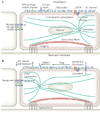Mechanotransduction in vascular physiology and atherogenesis
- PMID: 19197332
- PMCID: PMC2719300
- DOI: 10.1038/nrm2596
Mechanotransduction in vascular physiology and atherogenesis
Abstract
Forces that are associated with blood flow are major determinants of vascular morphogenesis and physiology. Blood flow is crucial for blood vessel development during embryogenesis and for regulation of vessel diameter in adult life. It is also a key factor in atherosclerosis, which, despite the systemic nature of major risk factors, occurs mainly in regions of arteries that experience disturbances in fluid flow. Recent data have highlighted the potential endothelial mechanotransducers that might mediate responses to blood flow, the effects of atheroprotective rather than atherogenic flow, the mechanisms that contribute to the progression of the disease and how systemic factors interact with flow patterns to cause atherosclerosis.
Figures






References
-
- Hynes RO, Zhao Q. The evolution of cell adhesion. J Cell Biol. 2000;150:F89–F96. - PubMed
-
- Hove JR, et al. Intracardiac fluid forces are an essential epigenetic factor for embryonic cardiogenesis. Nature. 2003;421:172–177. - PubMed
-
-
Lucitti JL, et al. Vascular remodeling of the mouse yolk sac requires hemodynamic force. Development. 2007;134:3317–3326. This work provides rather elegant evidence that fluid shear stress mediates the rearrangement of a primitive vascular plexus into a mature vascular tree in early mouse embryos.
-
-
-
Lusis AJ. Atherosclerosis. Nature. 2000;407:233–241. A good review that discusses the initiation and progression of atherosclerosis with emphasis on genetics, lipids and cellular interactions.
-
-
- Birukov KG, et al. Intraluminal pressure is essential for the maintenance of smooth muscle caldesmon and filamin content in aortic organ culture. Arterioscler Thromb Vasc Biol. 1998;18:922–927. - PubMed
Publication types
MeSH terms
Grants and funding
LinkOut - more resources
Full Text Sources
Other Literature Sources
Medical

